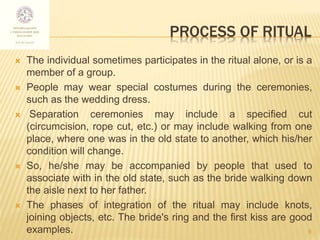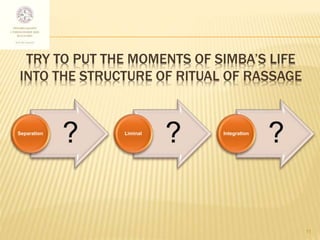Lion king and Rituals of Passage
- 1. THEOLOGY & CINEMA Lion King and Rituals of Passage 1 Dr. Georgios Gaitanos Lecturer of Religious Studies e-mail: gaitanosg@yahoo.gr
- 2. IS IT POSSIBLE? ? Is it possible to study a movie (especially a movie for children) as an ethnography? ? The film ¡°The Lion King¡± presents the story of a lion king, but according to its creators it relates to human situations as well as human myths. 2
- 3. THE STORY-THE CYCLE OF LIFE (1) Mufasa, animal king, has as a successor to his throne, Simba However, the king's brother, Scar, arrives to steal the throne. Setting up the perfect trap, he kills his brother. 3
- 4. THE CYCLE OF LIFE (2) He removes his little nephew in voluntary exile, and takes the throne. Little Siba now lives in the desert in an oasis trying to forget the past. His world view is 'akuna matata' and follows a carefree life. According to the magician, he is the heir to the throne and must succeed his father 4
- 5. THE CYCLE OF LIFE (3) After receiving signs from the community magician and seeing his father in vision, he fights with Scar for the throne. He wins the battle, becomes king and gets married, so he can have his own family and successor. 5
- 6. CASE STUDY ? The points of interest are not the acquisition of the throne or the battle for its acquisition. ? What interests us is the passage - the passing of the protagonists from one period of their life to another, and from one social situation to another. ? Issues such as birth, adolescence, marriage, death, exile, enthronement are those that will concern us, as ethnographic data provides us with rich material for rituals of passage. 6
- 7. RITUALS OF PASSAGE ? Rituals of Passage are a category of rituals, which mark the passage of a person through the life cycle, from one level to another and from one social position to another. ? The rituals reveal the relationship between human and cultural experiences with biological fate: birth, reproduction, death. 7
- 8. STRUCTURE ? Contact of sacred- secret symbols of the communal unity and continuity: ? a. Exhibition of objects ? b. Instructions (myths, catechesis, puzzles) ? c. Acts (representation of myth, dance, drama) Separation ? Removal of sanctity and reconfiguration of family cultural formations Liminal ? Simplifying of structural - social relations: ? a. Absolute power of the older over the younger ? b. Communitas among the initiates Integration 8
- 9. PROCESS OF RITUAL ? The individual sometimes participates in the ritual alone, or is a member of a group. ? People may wear special costumes during the ceremonies, such as the wedding dress. ? Separation ceremonies may include a specified cut (circumcision, rope cut, etc.) or may include walking from one place, where one was in the old state to another, which his/her condition will change. ? So, he/she may be accompanied by people that used to associate with in the old state, such as the bride walking down the aisle next to her father. ? The phases of integration of the ritual may include knots, joining objects, etc. The bride's ring and the first kiss are good examples. 9
- 10. THE ROLE OF RITUALS OF PASSAGE ? Rituals of passage are mainly ways of enabling change in social status without causing the symbolic structure of the community. ? The rituals of either passage or maintaining status are aiming at stability and harmony. ? Clearly, some changes are inevitable (birth, marriage, death, illness). But the purpose of rituals is to maintain cultural stability and non-destructive change. 10
- 11. TRY TO PUT THE MOMENTS OF SIMBA¡¯S LIFE INTO THE STRUCTURE OF RITUAL OF RASSAGE ?Separation ?Liminal ?Integration 11
- 12. 12











